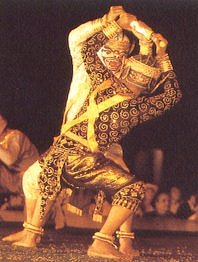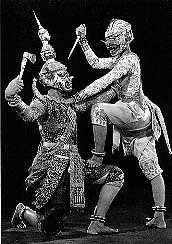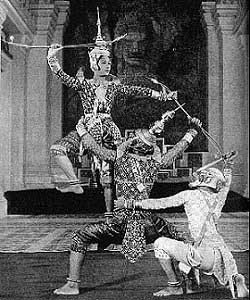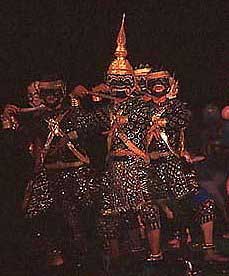|
Links
Ken
Kunthea's Dance Homepage
Youthful
Optimism
Chamrouen Yin's Classical Cambodian Dance Page
Danse Celeste
Apsara Dance
Poetry In Motion
Classical Cambodian Dance
A Determined Survivor Revives Khmer Classical
Dance
Classical
Cambodian Court Dance
Sovannaphum
Assoication
Sam Ang Sam's Khmer Music page
Scott's
Cambodian musical instrument report Khmer
Classical Dance at the Temple The
Dance Spirit of Cambodia The
Dance Spirit of Cambodia Arts & Culture |
|

Lakhon khol or masked theatre has become
a dying art because, most of the old masters died during the Pol Pot's Khmer Rouge regime.
Also it hasn't received enough support for the tradition to continue. On some occasions
performances are held by the Royal University of Fine Arts and Performing Arts. Before the
Khmer regime there were two lakhon khol troupes found in Battambang and Kandal
Province.
|
There is evidence from some
pagodas where Reamker (Ramayana) manuscripts were preserved, containing male
troupes comprising of the novice monks began performing in masked theatre. Masked theatre
is much similar to court dance and usually consist of importantly narration, mimes, song
and dance, much similar to royal court dance. Lakhon khol was believed to have
evolved along side with royal court dance as they both graced the royal Cambodian court in
the past as well as the present, with their spectacular dance repertoires that perform
scenes from the Reamker. However this was an all male tradition. Before 1975 there
existed only three masked theatre troupe one in Kandal Province and two in Battambang
Province. The future of lakhon khol is un-certain one and is of great concern
because, the Khmer Rouge had executed so many artists. |

Hanuman (white monkey) locked in battle
with Krong Reap (Ravana)
|
|
|
|

Lakhon khol dance spectacle, a scene
from the Reamker where Preah Ream ( Prince Rama) is standing on Krong
(Ravana) Reap and Hanuman behind Krong Reap. |
Masked theatre was assumed to have been
introduced during the reign of King Ang Duong into Cambodia in the mid-19th century,
however the art form maybe older and seems to have been performed during the Angkorean
Period from the 9th -15th century A.D. Lakhon khol corresponds to khon theatre of neighbouring Thailand. There were
troupes present in the Court of Oudong one female and one male. The female troupe was
considered to be the predominant one and came to be known as lakhon kbach boran
or robam boran Khmer.
However after the death of King Ang Duong the male troupe was dispersed from the royal
court to the homes of wealthy patrons and governors. |
|
Lakhon khol would be
performed during the nights of Khmer New Year (13-15th April) or during the ceremony to
worship spirits or to promote rain or to save villagers from epidemics and illnesses. The
typical themes are from the Reamker, therefore only some episodes are selected for
performances that are based on fortunate themes. It is believed that the Reamker
revolves around mundane lives of the villagers and the supernatural, villagers would
refused to perform any scenes involving deaths or separation fearing that it would promote
bad luck. However the death of secondary characters are tolerated.
|
Lakhon khol is
accompanied by the pin-peat
orchestra and the same for court dance and shadow theatre. Lakhon khol was also
believed to have actually evolved from nang sbek
(shadow theatre) as the performers traded their leather puppets for crowns, elaborate
costumes and masks. Basically the repertoires for lakhon khol and nang sbek
are the same. Therefore it would impossible for the actor-dancers speak because they are
wearing masks and the movements are simple and masculine thus sometimes lakhon khol
is called "men's dance".
His excellency Governor of Battambang Province
had a lakhon khol troupe of more than one hundred male performers. They performed
scenes from the Reamker, the role of Preah Ream (Prince Rama), Preah
Leak (Prince Laksamana), Hanuman (white monkey), monkeys, giants, hermits,
clowns, Krong Reap (Ravana) and also Neang Seda (Sita) was played by a man.
They would perform at an open pavilion where it would be lit by lamps if the performance
was at night. |

Monkey troops ready for battle, a scene from
the Reamker at the Ramayana Festival in 1995 at Angkor Wat |
|